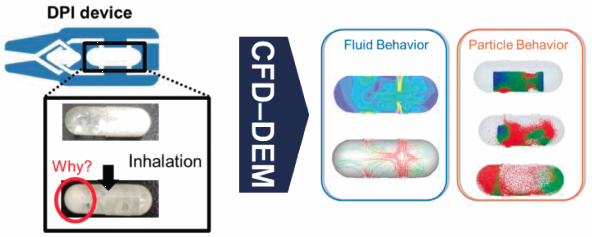- 著者
- Ryosuke Mitani Shuji Ohsaki Hideya Nakamura Satoru Watano
- 出版者
- The Pharmaceutical Society of Japan
- 雑誌
- Chemical and Pharmaceutical Bulletin (ISSN:00092363)
- 巻号頁・発行日
- vol.68, no.8, pp.726-736, 2020-08-01 (Released:2020-08-01)
- 参考文献数
- 40
- 被引用文献数
- 10
This study investigated the particle adhesion mechanism in a capsule of dry powder inhaler (DPI) based on a combined computational fluid dynamics and discrete element method (CFD–DEM) approach. In this study, the Johnson–Kendall–Roberts (JKR) theory was selected as the adhesion force model. The simulation results corroborated the experimental results—numerous particles remained on the outlet side of the capsule, while a few particles remained on the inlet side. In the computer simulation, the modeled particles were placed in a capsule. They were quickly dispersed to both sides of the capsule, by air fed from one side of the capsule, and delivered from the air inlet side to the outlet side of the capsule. It was confirmed that vortex flows were seen at the outlet side of the capsule, which, however, were not seen at the inlet side. Numerous collisions were observed at the outlet side, while very few collisions were observed at the inlet side. These results suggested that the vortex flows were crucial to reduce the amount of residual particles in the capsule. The original capsule was then modified to enhance the vortex flow in the area, where many particles were found remaining. The modified capsule reduced the number of residual particles compared to the original capsule. This investigation suggests that the CFD–DEM approach can be a great tool for understanding the particle adhesion mechanism and improving the delivery efficiency of DPIs.
